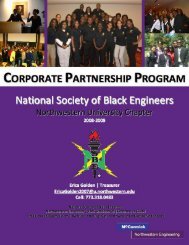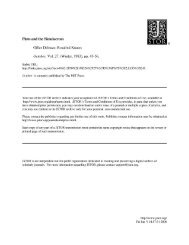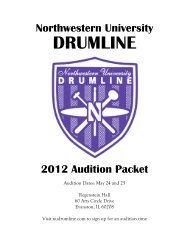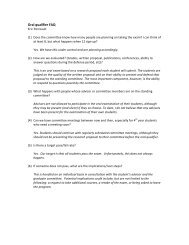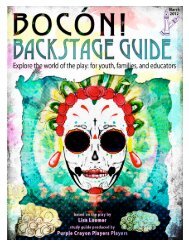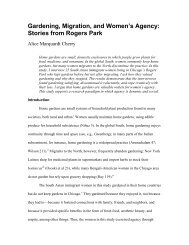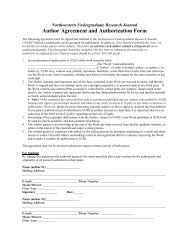RESEARCHas some of the other benefits of volunteering. However,the social factors were found to be more important tohighly committed volunteers.” (Ryan, Kaplan, Grese,646, 2000) In the studies examined here, no correlationwas found between the actual age, distance needed totravel to sites or time available to the volunteers andtherefore were not factors that influenced the levels ofcommitment, frequency or duration of the volunteerswork. With these concepts in mind, we attempted totease out the underlying motives of undergraduate<strong>Northwestern</strong> <strong>University</strong> students who participate inVES and voluntary service in general.III. MethodsA. Organization BackgroundThe survey that was administered is aimed at discerningthe motives of participation and continuedservice, and assumes that the undergraduate <strong>Northwestern</strong>students examined here have some level of interestin environmental service or service in general. For thatreason, we chose to examine three distinct student organizationcategories: Alternative <strong>Student</strong> Breaks (ASB),<strong>Student</strong>s for Ecological and Environmental Development(SEED) and a general service category.These groups were chosen to represent sets of participantsthat either focus specifically on environmentalservice or are participating in general voluntary serviceon campus. We studied two ASB participant sets,one concerning the environment and one concerningpoverty. One important distinction between the participantssurveyed in ASB versus SEED is noteworthy.ASB participants only work on site for one week, whilethey do reflect and prepare for their service it should beunderstood as a lighter time commitment. Conversely,SEED focuses primarily on environmental issues andtypically the members have a greater time commitmentby participating in events and meetings throughout theentire academic year. A third group examined consistsof undergraduate individuals who take part in servicebut are not associated with a particular group examined.These individuals have a variation of commitmentlevels. Moreover we will analyze our results by lookingat different outcomes in regards to one’s community,gender, and youth background information.B. Dependent VariableThe dependent variable for this project is the civicaction returns rate. Civic action returns rate is simplythe willingness of a participant to continue to servetheir community. We are exploring the extent by whichfundamental motives have on the willingness to serve byusing multiple correlations between these data sets.C. Independent VariablesThe survey was coded for four independentvariables:(1) Attraction to Public Policy Making: the degree towhich formulating good public policy is viewed asexciting, dramatic, and self- fulfilling (three items);(2) Commitment to the Public Interest: the degree towhich the person is motivated to pursue a careerthat allows serving in the public interest (five items);(3) Compassion: the degree to which an individual experiencesmoral and affective regard for needy persons(eight items);(4) Self Sacrifice: the degree to which a person puts theoutcomes of public service before personal benefits(eight items).While these variables may have some degree of overlapand interaction, “confirmatory factor analysis [has]differentiated the four factors of motives for public service”(Perry, 1996).D. Confounding VariablesThe pool by which we selected survey participantshad some selection bias. Only <strong>Northwestern</strong> studentswere surveyed, thus locking the data in a pool withmany predetermined demographics (age, educationlevel, privilege), but <strong>Northwestern</strong> remains to be a quitediverse community (race, class, gender) and due to itsprestige, we believe this is an important area of <strong>research</strong>exploration.E. Survey SpecificsThe survey constructed use empirically confirmedquestions found in the Public Service Motivation Scale(Perry 1993) and the Civic Action Scale (Moely, Merceret al., 2002).(1) Public Service Motivation Scale ValidityPublic service motivation represents one’s “dispositionto respond to motives grounded primarily oruniquely in public institutions.” (Perry, 1993) Age wasnot “significantly related to the Attraction to PolicyMaking, Compassion, or Self-Sacrifice subscales.”(Perry, 1997) Moreover, Perry (1997) found that maleparticipants scored higher on the Commitment to thePublic interest and self-sacrifice than their female counterparts.(2) Civic Action Scale ValidityThe Civic Action scale measures “intentions to becomeinvolved in the future in some community serviceor action.” (Moely, Mercer et al., 2002, p. 15) Surveyresults indicated that students participating in service66 NORTHWESTERN UNDERGRADUATE RESEARCH JOURNAL
RESEARCHlearning significantly increased on civic action, whilestudents in the traditional classroom setting did not.Moreover, female students scored “higher than malestudents on the Civic Action scale in two samples, aftercontrolling for Social Desirability.” (Moely, Mercer et al.,2002)IV. Data & AnalysisA. Descriptive Statistics(1) General DistributionsFigure 1 is a comprehensive motive distributionacross the four organizational categories surveyed.While, it is very accurate in describing motives, it isdifficult to generalize, due to the specificity of the organizations.Our sample population being 44 studentsis significant considering that the entire population at<strong>Northwestern</strong> <strong>University</strong> is around 8000 students, makingour sample 0.55% of the population, yet this doesnot represent percent of the civically engagement population,just the overall student body. However, when furthercategorized between organizations, the sample sizebecomes so small that our results may have anomalies.Specifically two data sets, attraction to public policy inregards to ASB-Environmental and self-sacrifice in regardsto ASB-Non-environmental, diverged significantlyfrom the norm. We cannot make a generalization onthis data, so instead we further analyzed it through aggregateunderstandings, so we could effectively compareVES vs. VS.Figure 2 has a few interesting data trends. First, foreach of the categorizes surveyed, VES was found to havehigher or exactly even motive levels to that of the VSsurvey group of individuals. Particularly note worthywere the extreme deviations in regards to the attractionto public policy aggregate. This increase can partiallybe accounted for by the observations in Figure 1, thatthe ASB-Environmental group had particularly highattraction to public policy. Further, it appears that theself-sacrifice aggregate is overall higher for those whotake part in service that is of environmental themes.Finally, the <strong>Northwestern</strong> <strong>University</strong> students who weresurveyed have resulted in near identical indications oftheir civic action returns in addition to their compassionlevels. We believe that the civic action return ratesare so similar due to the nature of <strong>Northwestern</strong> <strong>University</strong>students, in addition to how the service is inherentlycompleted. This indicates that the type of servicewhich is completed does not necessarily correlate withthe return levels, but instead that individuals are morelikely to return based on what they personally gain fromthe service experience.(2) SexIn regards to sex, the significant statistical deviationsas seen in Figure 3 were compassion and self-sacrifice.We believe that these results represent broader differencesin sex. Furthermore, seeing that the deviationsin both motives are similar for sex, we investigated therelationship between compassion and self-sacrifice.R-squared value of 0.32, meaning that there is someco-linearity between these two variables, which is notsurprising considering that those who are willing to selfsacrificemight have developed a large degree of empathy,which can coincide with compassion.(3) CommunityIn terms of community background, Figure 4 showsstudents who identified with an urban upraising weremore likely to be attracted to public policy making,while those from suburban backgrounds preferred commitmentto public interest. We assume this to be thecase because of the interactions a given student mayhave encountered throughout their upbringing. Specificallyand dense urban areas, politics and political activ-Figure 1: Motive DistributionFigure 2: Motive Distribution VES vs. VSVOLUME 7, 2011-2012NORTHWESTERN UNDERGRADUATE RESEARCH JOURNAL67



